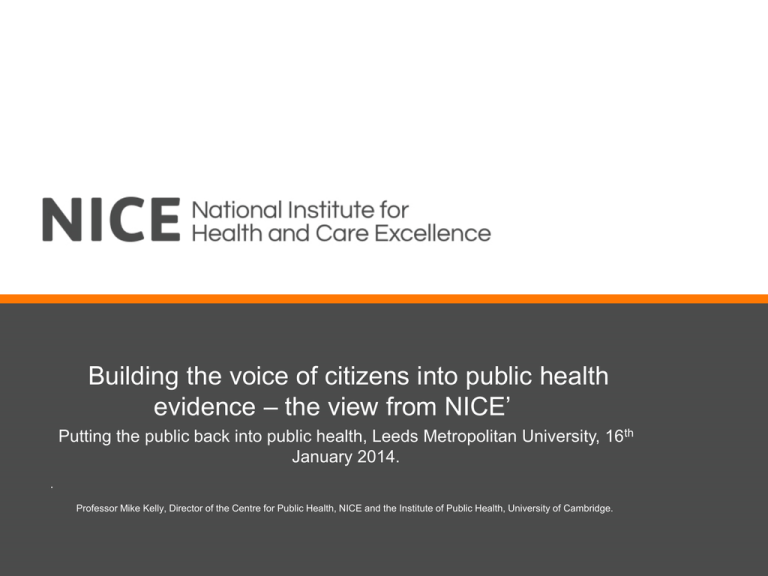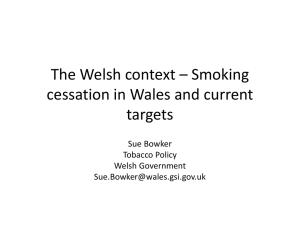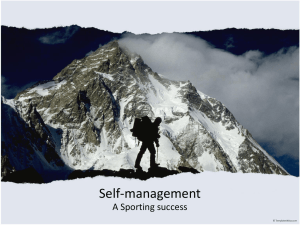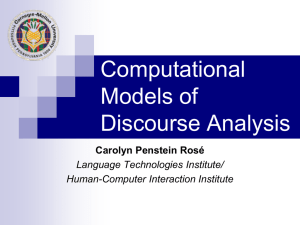
Building the voice of citizens into public health
evidence – the view from NICE’
Putting the public back into public health, Leeds Metropolitan University, 16th
January 2014.
.
Professor Mike Kelly, Director of the Centre for Public Health, NICE and the Institute of Public Health, University of Cambridge.
Key ideas.
• Practical steps at citizen involvement.
• Theoretical implications for Public Health
Guidance.
NICE needs
YOU
Stakeholder involvement
• Scope of the work drawn up by the NICE
team.
• Scope published on the web.
• Public stakeholder meeting.
• Stakeholder comments received and
responded to on the web
• Scope amended and final version published.
Who writes the guidance?
Guidance developed
• Evidence reviewed.
• Evidence appraised.
• All committees have lay and community
members on them.
• Draft recommendations published.
• Stakeholders comment on the draft
recommendations.
• Recommendations revised.
• Guidance published.
The Public Involvement
Programme at NICE
•
•
•
•
Recruits lay members to committees.
Inducts the lay members.
Provides on going support to lay members.
The importance of the lay and community
perspective.
• Meetings held in public.
• http://www.nice.org.uk/getinvolved/patientsand
public/patientandpublichome.jsp
The Citizens’ Council
•
•
•
•
30 members of the general public.
Deliberates on complex problems.
Presents independent reports to the Board.
Its views help to frame the production of NICE
guidance.
A methodological and
theoretical departure.
The discourse of risky
behaviours
• Tobacco
The discourse of risky
behaviours
• Tobacco
• Alcohol
The discourse of risky
behaviours
• Tobacco
• Alcohol
• Inactivity
The discourse of risky
behaviours
•
•
•
•
Tobacco
Alcohol
Inactivity
Food
The discourse of risky
behaviours
•
•
•
•
•
Tobacco
Alcohol
Inactivity
Food
Drugs
The discourse of risky
behaviours
•
•
•
•
•
•
Tobacco
Alcohol
Inactivity
Food
Drugs
Travel
The discourse of risky
behaviours
•
•
•
•
•
•
•
Tobacco
Alcohol
Inactivity
Food
Drugs
Travel
Sex
The discourse of risky
behaviours
•
•
•
•
•
•
•
•
Tobacco
Alcohol
Inactivity
Food
Drugs
Travel
Sex
Age
The discourse of risky
behaviours
•
•
•
•
•
•
•
•
•
Tobacco
Alcohol
Inactivity
Food
Drugs
Travel
Sex
Age
Being alive
The discourse of risky
behaviours
•
•
•
•
•
•
•
•
•
Tobacco
Alcohol
Inactivity
Food
Drugs
Travel
Sex
Age
Being alive
The discourse of risky
behaviours
•
•
•
•
•
•
•
•
•
Tobacco
Alcohol
Inactivity
Food
Drugs
Travel
Sex
Age
Being alive
The discourse of risky
behaviours
•
•
•
•
•
•
•
•
•
Tobacco
Alcohol
Inactivity
Food
Drugs
Travel
Sex
Age
Being alive
Social practice.
• Social practices not behaviour.
• Acknowledges agency and structure.
• Non–determinist.
Theories of Social Practice and Public
Health
Conventional methods of understanding and influencing
non communicable disease and smoking, obesity, alcohol
Something
missing
“wider determinants”
Behaviour and
lifestyle choices
Nudge, getting
messages across,
enabling people to
make better
choices for
themselves.
• materials (objects, consumer goods, infrastructures);
• competence (including understandings of the situation;
practical know-how)
• meanings (including embodied understandings of the
social significance of the practice; past experiences of
participation etc.).
X
Y
XX1
D
C
B
A
Y
X4
P
O
X2
N
H
G
F
M
E
X1
D
C
B
A
I
J
K
L
R
X3
S
T
X5
Q
Y
4
P
O
N
H
G
F
M
E
X1
D
C
B
A
I
J
K
L
R
X3
S
T
X5
Q
Y
How practices change
Practices depend on the active integration of elements.
Practices emerge and change when new links are made
Practices disappear when links are broken.
competence
meanings
competence
materials
A practice –
in which elements are
linked
meanings
materials
An ex-practice In which links
between elements
are broken
Tobacco smoking
How has the practice
has evolved?
Smoking has changed significantly
during the course of its 2,000 year
‘lifetime’.
How the elements of the
practice have changed?
What are the materials, the
meanings, the skills involved?
Who is captured
by the practice?
How does smoking relate
to other social practices?
Who smokes, social class
associations, gender, age?
Drinking, relaxing, taking a break,
eating.
Smoking depends on an
integration of
materials: not only, cigarettes,
matches and lighters; but also
tobacco plants, factories,
transport systems, retail
infrastructures, an economy..
competence: to know how to
smoke, not only practically how to
light a cigarette and inhale; but
how to smoke in the ‘correct’
manner for a given social situation
e.g. in a beer garden, during a
break at work
meaning: understanding that
smoking is a normal and socially
acceptable thing to do, variously
associated with relaxation,
sociability, masculinity, glamour
and toughness.
http://www.morguefile.com/archive/#/?q=cigarette&sort=pop&photo_lib=morgueFile
Practices make and use social networks?
People are linked by practices, practices recruit through networks
Example of social network from Nick Crossley
Social practices interact – links are made and broken between one practice
and another
“wider determinants”
Impasse
Behaviour and
lifestyle choices
Nudge, getting
messages across,
enabling people to
make better
choices for
themselves.
Social
practices
that persist across
space and time
That have lives of
their own
That are constantly
on the move
Conclusions
'Many of the triumphs of public health in the past
...relating to infectious diseases have been brought
about by primary prevention. Similar victories over those
modern maladies , the chronic degenerative diseases
seems however far from grasp. ....[T]he strategies of
preventive medicine do not seem to have come to grips
with the sorts of behavioural and societal manipulations
necessary to allow these conquests to be made'
(Donaldson & Donaldson, 1983:130).[ Donaldson, R.J. &
Donaldson, L.J. (1983) Essential Community Medicine
(Including Relevant Social Services) , Lancaster: MTP
Press.]
Implications
• We need to understand the lived
experience of citizens in their lifeworlds.
• We need to eschew predictive causal
models.
• We need to understand the relational
nature of social life.








